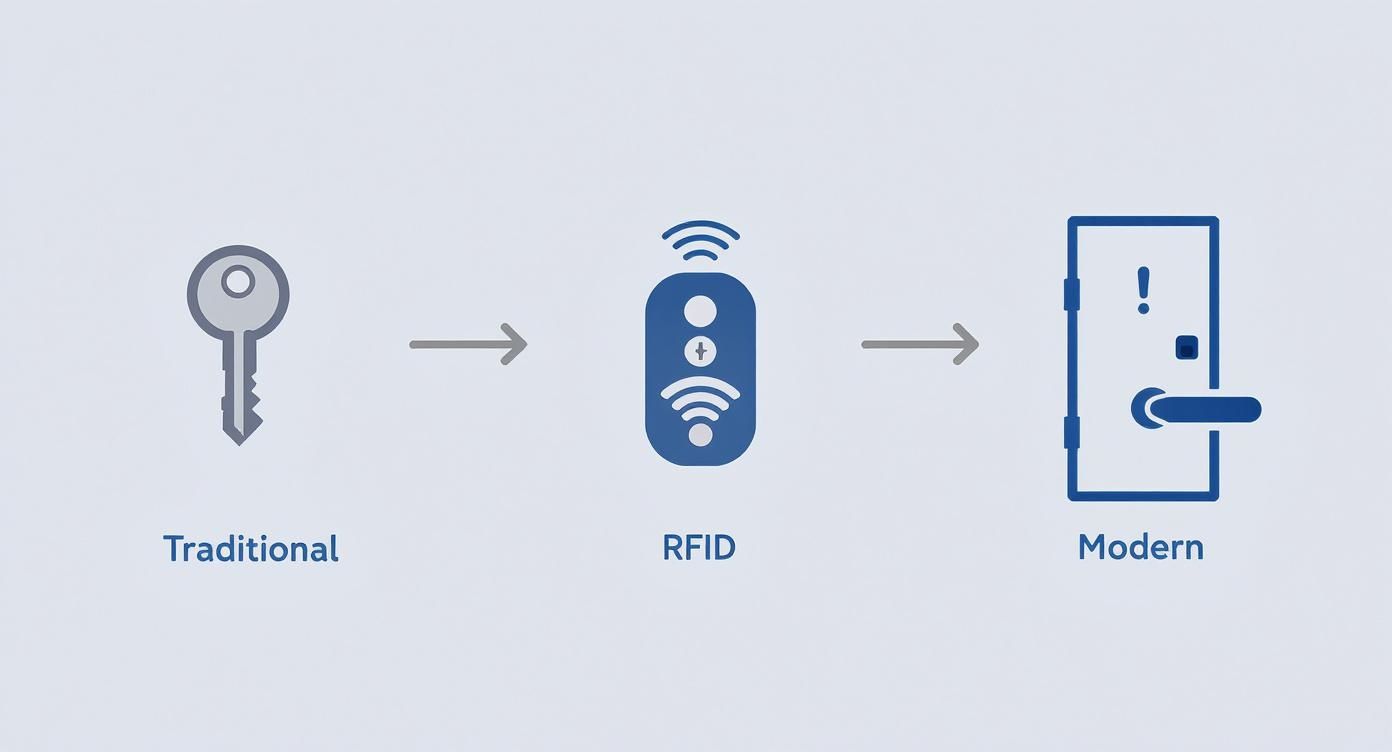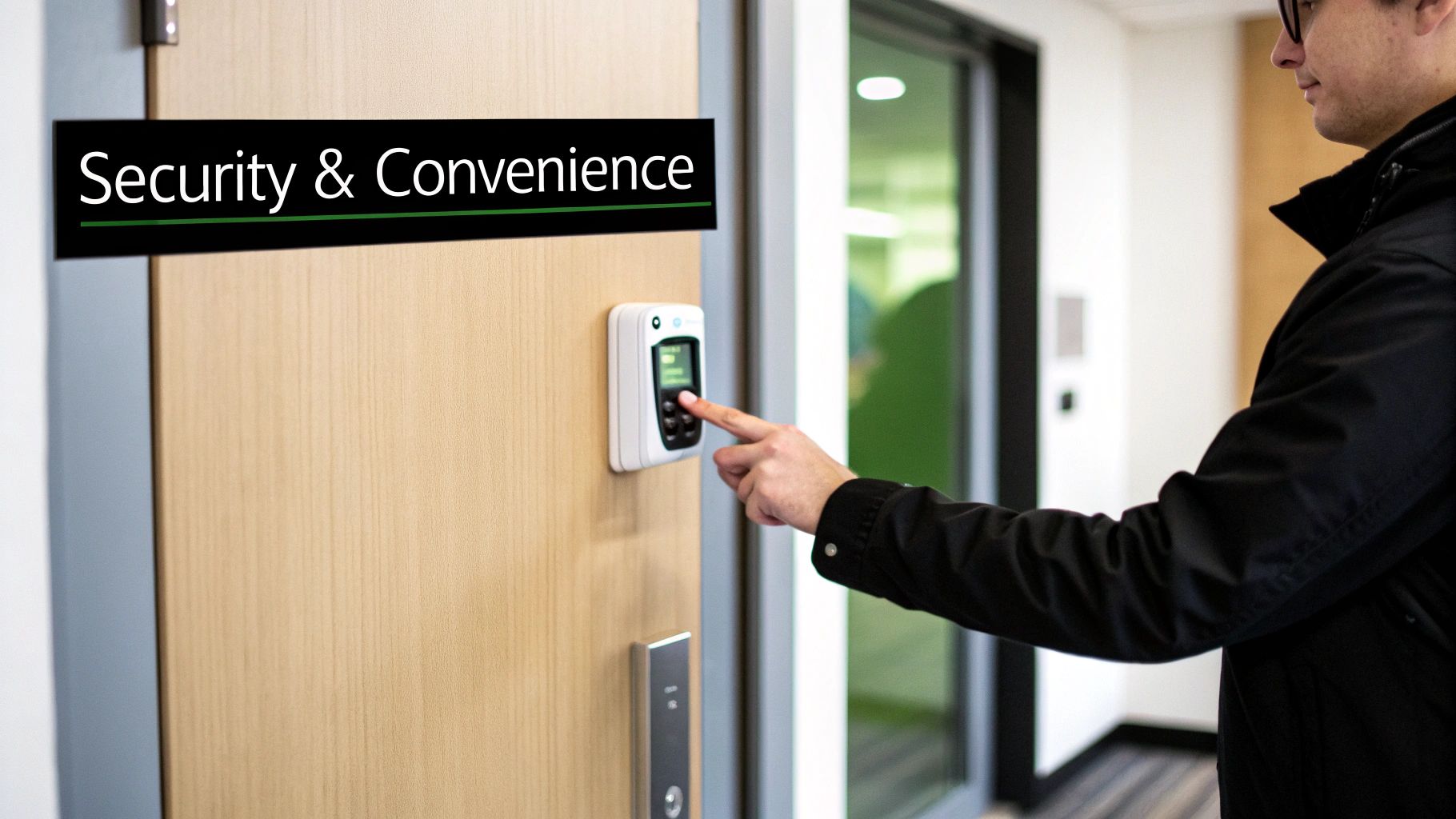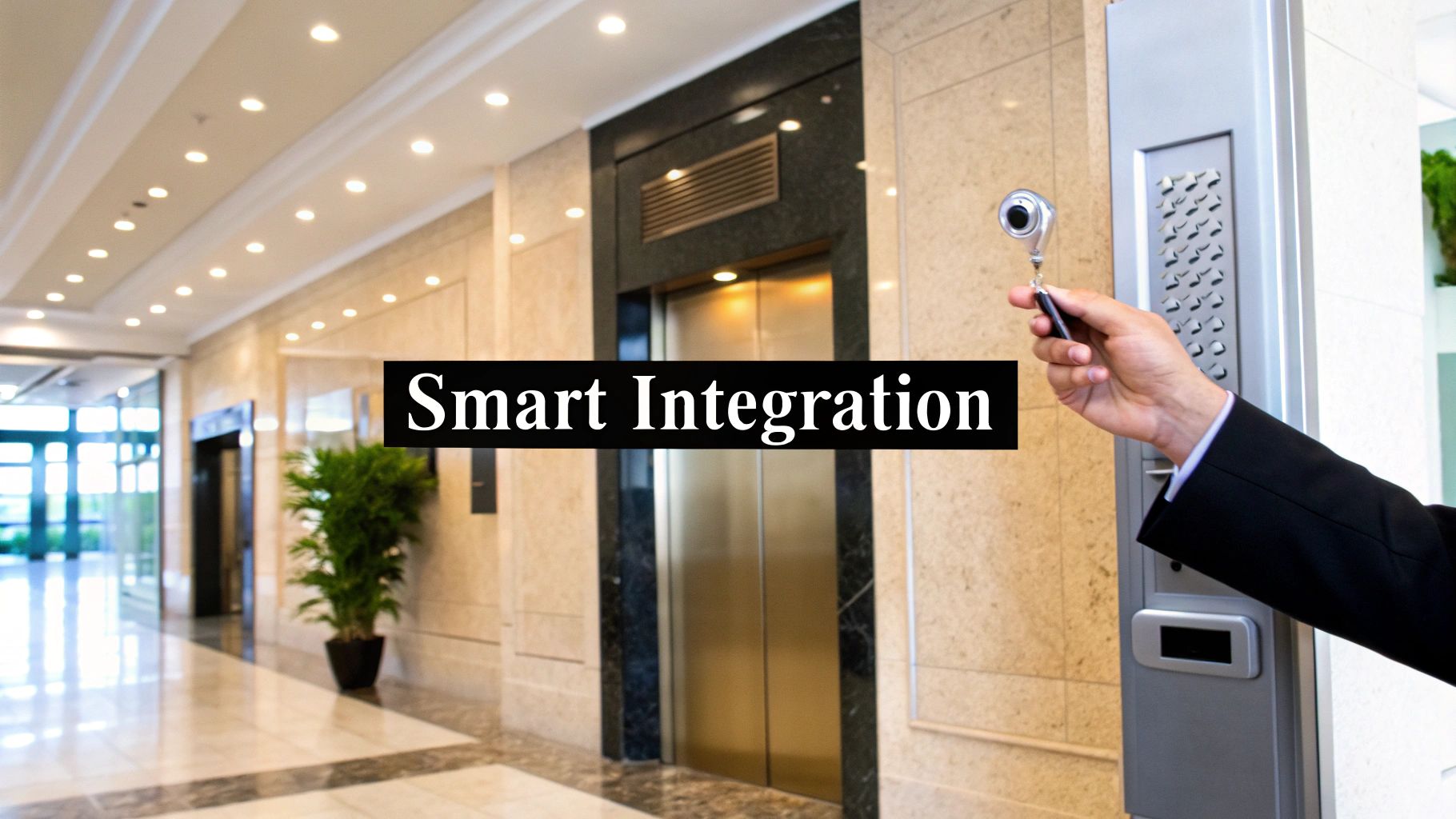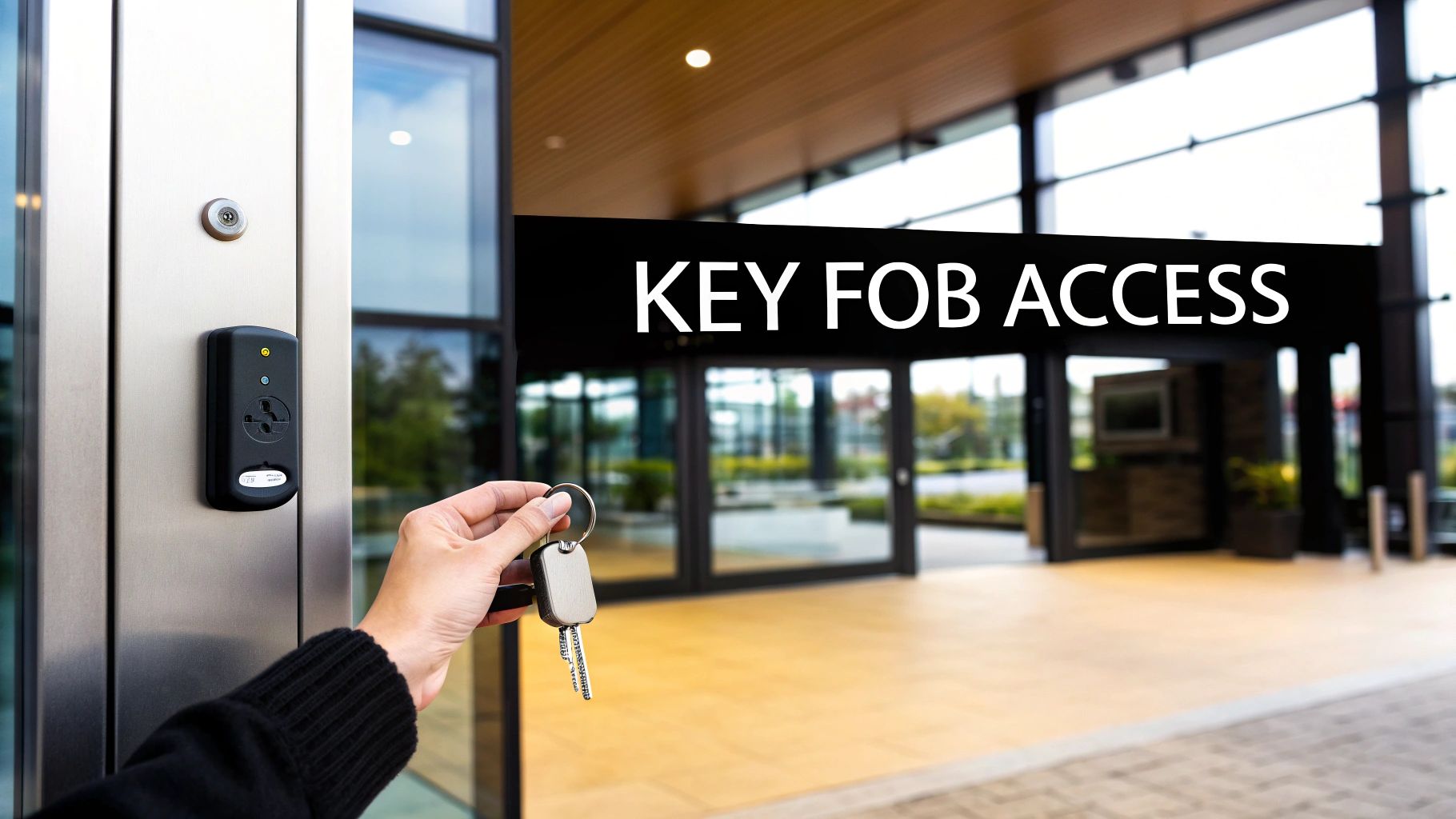Think of the last time you fumbled for a set of keys. Now, imagine replacing that entire clunky keychain with one small, sleek device that opens every door you need with just a simple wave. That’s the magic of a key fob door entry system.
It's essentially a digital handshake. When your fob gets close to the door's reader, it sends out a unique, secure signal. The system recognizes you, verifies you have permission, and click—the door unlocks. This all happens in a split second.
At its heart, this technology is powered by Radio-Frequency Identification (RFID), and it has quickly become a go-to security solution for both homes and businesses.
What Are Key Fob Door Entry Systems
A key fob system fundamentally changes how we think about access. Instead of dealing with physical keys that can be lost, stolen, or copied, we move into a secure, easily managed digital space. Need to give someone new access? You just program a new fob for them. No more expensive locksmith calls.
This is more than just a convenient way to open a door; it’s about having total control over who can enter your space and when. It creates a smooth, frictionless experience for people who belong, while putting up a serious, modern barrier for those who don't.
How It All Works Together
This seemingly simple process relies on three key pieces of hardware working in perfect sync:
- The Key Fob: This is your digital key. It's a small, portable device with a tiny RFID chip inside, holding your unique access credentials.
- The Reader: Installed next to the door, this device is constantly listening for a signal from a fob. When one comes into range, it reads the data.
- The Control Panel: This is the brains of the operation. It receives the fob's data from the reader, checks it against an approved list, and tells the door's electric lock to open.
The move towards this kind of smart access control isn't just a niche trend; it's a massive industry shift. The global market for door entry systems hit around USD 10.55 billion in 2025 and is only expected to keep growing. While we often think of this for buildings, the same core idea is used elsewhere—you can see the parallels by understanding keyless entry systems for cars.
Key fob systems don't just replace your metal keys. They introduce an intelligent, flexible, and fully trackable layer of security that traditional locks simply can't offer.
Ultimately, these systems give you a much stronger and more sophisticated way to manage who comes and goes. They're a close cousin to other modern access solutions, and you can dive deeper into a similar technology in our guide on https://clouddle.com/blog/keypad-entry-systems/.
How Does Key Fob Technology Actually Work?
Ever wonder what happens in that split second when you tap your fob and the door clicks open? It might seem like a bit of magic, but it’s actually a brilliant and lightning-fast digital conversation. The whole thing relies on three key pieces of hardware working in perfect sync to confirm you belong there.
At its core, this is all built on Radio-Frequency Identification (RFID) technology. If you've ever used a tap-to-pay credit card or a transit pass, you're already familiar with the concept. It’s a secure and reliable way to replace old-school metal keys, getting rid of headaches like unauthorized key copies for good.
The Three Key Players in the System
Every key fob entry system, no matter how simple or complex, has a trio of essential components that make the magic happen:
-
The Key Fob: This is your personal credential, the digital equivalent of a key. Tucked inside that small plastic shell is a microchip with a unique ID number and a tiny antenna. The fob itself is passive—it has no battery and just waits for a signal to wake it up.
-
The Reader: This is the device you see mounted on the wall next to the door. It’s constantly emitting a low-power radio field, essentially scanning the area for a fob. It acts as both a power source and a listening post.
-
The Control Panel: Think of this as the brains of the operation. It's wired to the reader and the door's locking mechanism. This panel holds a secure database of every authorized fob ID and the specific rules for each one (like which doors it can open and when).
This infographic really puts into perspective the leap from traditional keys to modern key fob systems.

You can see how we've moved from a purely physical interaction to a wireless, data-based transaction, which is the foundation of modern access control.
The Digital Handshake: A Step-by-Step Breakdown
When you hold your fob up to the reader, a very specific chain of events is triggered. It all happens in the blink of an eye. I like to call it a "digital handshake"—a quick, secure check to verify your identity.
Here’s exactly what’s going on behind the scenes:
- Step 1: Power Up: The fob enters the reader’s radio frequency field. This energy is just enough to power up the tiny chip inside the fob—no battery needed.
- Step 2: ID Transfer: Once it has power, the fob uses its little antenna to broadcast its unique ID number back to the reader.
- Step 3: Verification: The reader catches the ID and immediately passes it along to the control panel.
- Step 4: The Decision: The control panel checks the ID against its database. Is this ID valid? Does it have permission for this door at this time of day? If everything checks out, it sends a signal to the lock.
- Step 5: Access Granted: The electric lock receives the signal and disengages. The door is unlocked.
The most impressive part? This entire process, from the fob waking up to the door unlocking, takes less than a second. It delivers a seamless experience for the user while maintaining a level of security and control that a simple lock and key could never hope to achieve.
The Twin Pillars: Unbeatable Security and Everyday Convenience
When you peel back the technical layers, the true power of a key fob system boils down to two things: a major upgrade in security and a huge boost in day-to-day convenience. It’s this one-two punch that solves the oldest problems in managing a building—keeping people and property safe without making it a hassle for authorized folks to get in.
The most obvious win is leaving the vulnerabilities of old-school metal keys behind. Lose a traditional key, and you're stuck with a tough choice: either live with the security risk or pay for a costly and disruptive re-keying of the entire lock. With a key fob system, a lost fob is a minor hiccup, not a full-blown crisis.

A Major Leap in Security Control
An administrator can simply log into the management software and deactivate a lost or stolen fob in seconds. Just like that, it's a useless piece of plastic. This single feature delivers incredible peace of mind and saves a fortune in operational headaches over the years. No more emergency calls to the locksmith or the logistical nightmare of handing out new keys to everyone.
Key fobs also put a stop to unauthorized key copying. A standard metal key can be duplicated at just about any hardware store, creating a security hole you may never know about. Modern encrypted fobs, on the other hand, are incredibly difficult to clone, so you can be confident that only approved credentials will open your doors.
Then there’s the audit trail. Every scan, every door opened—it's all logged. The system creates a detailed digital record showing who went where, and when.
This digital footprint is an absolute game-changer for security audits and investigating incidents. It turns the simple act of opening a door into a source of valuable, actionable data.
Unlocking a New Level of Convenience
On the flip side, the convenience factor is just as impressive, especially in buildings with lots of people coming and going. Picture managing an office, an apartment complex, or even a school without ever touching a physical key.
Suddenly, managing access becomes remarkably straightforward:
- Effortless Onboarding: When a new employee or tenant starts, you can issue them an active fob on the spot. No need to hunt down a master key to make a copy.
- Instant Offboarding: As soon as someone leaves the organization, their access can be revoked with a single click. The risk of unreturned keys vanishes completely.
- Temporary Access: Need to let in a contractor, a cleaning crew, or a visitor? You can grant them access to specific doors for a set period, ensuring they can only get in when and where you want them to.
This kind of centralized control makes life so much easier for facility managers and property owners, freeing them up from tedious, manual tasks. And for the users, it’s a world of difference. No more fumbling with a bulky keyring—just a simple tap or wave, and they’re in. This frictionless experience doesn't just feel more modern; it projects an image of a secure, professionally managed property, which goes a long way toward keeping tenants and employees happy.
Integrating Key Fobs into a Smart Building
A modern key fob system is so much more than a digital doorman. Think of it as the central nervous system for an intelligent building. These systems almost never work in isolation anymore. Instead, they’re designed to connect with other technologies, turning a simple door entry into a whole series of smart, automated actions that boost both security and efficiency.
It’s a bit like a conductor leading an orchestra. When an employee swipes their fob at the door after hours, the system doesn't just click the lock open. It can also tell the alarm to disarm for that specific area, prompt the lobby cameras to start recording, and even signal the HVAC system to bring the temperature up in that person's workspace.

This kind of deep connection creates a truly responsive environment where all the building's systems are talking to each other. It’s this seamless integration that's really pushing the market forward.
Creating a Cohesive Security Ecosystem
The real magic happens when you start building a unified security and management platform. By tying your key fob system into other critical building technologies, you can unlock some seriously powerful new capabilities and get a much clearer picture of what’s happening on-site. This network effect is a core principle behind the Internet of Things in buildings.
Here are a few of the most common integrations we see:
- Video Surveillance: This is a big one. Linking your access control to your security cameras is incredibly valuable. When someone uses a fob—or if a door is forced open—the system can instantly tell nearby cameras to start recording and ping security staff with the live video feed.
- Alarm Systems: An authorized entry can automatically disarm the building’s alarm, while an unauthorized attempt can instantly trigger it. This simple connection cuts down on frustrating false alarms from user error and guarantees a swift response when a real threat occurs.
- Elevator Controls: In a multi-story building, you can program the system to manage elevator access. An employee's fob might only grant them a ride to the floor their office is on, adding another quiet but effective layer of security for sensitive departments.
By weaving these technologies together, a key fob door entry system moves from being a reactive tool to a proactive one, creating a building that actively participates in its own security.
Streamlining Operations Beyond Security
But integration isn't just about locking things down. It also brings some major operational wins that save a surprising amount of time and money. For instance, linking the access control system with HR software can completely automate the process of onboarding and offboarding employees.
When a new person is added to the HR system, a fob can be automatically assigned with all the right permissions. And when someone leaves the company? Their access is cut off everywhere, instantly. No more worrying about unreturned keys or fobs.
The demand for these smarter, more connected solutions is obvious. The global keyless entry system market was valued at USD 3.38 billion in 2024 and is on track to hit nearly USD 8.19 billion by 2032. This isn't just a trend; it's a clear signal that businesses want access solutions that do more than just open doors—they want systems that make managing the entire building simpler.
How to Choose the Right Key Fob System
Picking the right key fob system can feel like a huge task, but it doesn't have to be. The best way to start is by asking a few simple questions about your property and your day-to-day operations.
It's less about finding a "perfect" system and more about finding the perfect fit for your needs right now—and where you see yourself in a few years. Let's break down how to get there.
First, Look at Your Property's Size and Scope
Before you get lost in features and tech specs, start with the basics: How many doors are you trying to secure? And how many people need to get through them? Answering these two questions will immediately point you in the right direction.
For a small shop or office with just one main entrance, a simple standalone system is usually the way to go. It's practical, affordable, and does the job without any fuss. These units are all-in-one, meaning the reader and the brains are in the same box, making installation straightforward.
But what if you're running a larger operation? Think apartment complexes, multi-story offices, or any facility with several secure areas. In that case, you'll need to step up to a networked system. These systems link every reader back to a central hub, giving you a single point of control over the entire property.
A networked approach transforms your key fob system from a collection of individual locks into a single, cohesive security platform that can be managed from anywhere.
If you're mapping out a security plan from scratch, our guide on access control for business is a great resource for thinking through the bigger picture. It's about building a security foundation that can grow with you.
On-Premise vs. Cloud-Based: Where Will Your System Live?
Once you know you need a networked system, the next fork in the road is deciding where the "brain" of that system will be located. This is the classic on-premise versus cloud-based debate, and it really comes down to how you want to manage things.
-
On-Premise Systems: This is the traditional route. You have a dedicated server right there on your property that stores all the software and access data. The big advantage is you have complete physical control. The trade-off? You're responsible for all the maintenance, software updates, and data backups.
-
Cloud-Based Systems: This is the modern, more flexible approach. All the management happens through a web portal or a mobile app, and the provider takes care of the servers, security, and updates. It's incredibly convenient, letting you manage access from anywhere and add new doors or users without any hardware headaches.
System Type Decision Matrix
To make the choice a bit easier, here’s a quick comparison of how each system type stacks up against common needs.
| Feature | Standalone System | On-Premise Networked | Cloud-Based Networked |
|---|---|---|---|
| Best For | Single-door offices, small shops | Medium-large buildings, campuses | Any size property, multi-site businesses |
| Management | Manual programming at the door | On-site server, desktop software | Web browser, mobile app (from anywhere) |
| Scalability | Very limited (1-2 doors) | Good, but requires hardware upgrades | Excellent, easily add doors & locations |
| Upfront Cost | Low | High (server hardware, software) | Moderate (readers, subscription) |
| Ongoing Cost | Minimal | IT maintenance, potential upgrades | Monthly/annual subscription fee |
| Remote Access | No | Limited (often requires VPN) | Yes, built-in feature |
| Data Backup | Not applicable | Your responsibility | Handled by the provider |
This table should give you a solid starting point for figuring out which path aligns best with your budget, IT resources, and operational style.
Don't Forget Security, Scalability, and Integration
As you narrow down your options, keep a few final, crucial factors in mind. These are the things that separate a good system from a great one.
First and foremost, look for systems that use strong encryption. This is non-negotiable. Without it, your key fobs could potentially be cloned, defeating the whole purpose of the system.
Next, think about the future. Your business is going to grow, right? Make sure the system you choose can grow with you. Adding more doors or hundreds of new users shouldn't require a complete overhaul.
Finally, consider the big picture. Your access control system doesn't exist in a vacuum. It should play well with other tools you use. For property managers, for example, integration is huge. Checking that your system can connect with essential property management software features can make a world of difference in your daily efficiency.
Busting Common Myths About Key Fob Systems
Like any technology that’s been around for a while, key fob systems have their fair share of myths. These old stories can sometimes stop a business from even considering a security upgrade that could make a world of difference. Let’s set the record straight and look at the facts behind the fiction.
The biggest fear I hear is that key fobs are easy to clone. And to be fair, that was a valid concern with much older, unencrypted fobs. But modern systems are a completely different animal, using advanced encryption that makes unauthorized copying nearly impossible.
Think of it this way: an old fob is like a simple house key you could get copied at any hardware store. A modern, encrypted fob is more like a high-tech bank vault key. The technology has jumped light-years ahead.
"Aren't Key Fob Systems Too Expensive and Complicated?"
This is another classic myth—that key fob systems are only for giant corporations with bottomless budgets. The reality is the market is full of options designed to scale. A small shop can easily secure its front door with a simple, affordable system. A growing company can start with a few doors and expand its networked system as needed. The idea that this is an "enterprise-only" solution is just plain wrong.
Then there's the worry that managing a key fob system requires an IT genius. With today's software, that couldn't be further from the truth. Granting or revoking someone's access is usually just a few clicks in a web dashboard or a smartphone app. You don't need a technical background at all.
The real beauty of modern key fob systems is their blend of powerful security and simple operation. They're built to be easy for the person managing the system and even easier for the people using the fobs every day.
You can see the public's trust in this kind of technology in other areas, too. Just look at the automotive world. The keyless entry market, which is all about fobs, is expected to hit USD 3.02 billion by 2029. That kind of growth shows just how much people rely on the security and convenience fobs offer. If you're interested in the numbers, you can read the full research on keyless entry market trends.
Got Questions? We've Got Answers
It’s natural to have questions when you’re thinking about upgrading your building's security. Let's tackle some of the most common ones we hear from people just like you.
What Happens If Someone Loses Their Key Fob?
This is probably the number one concern, and thankfully, it has a simple, stress-free answer. If a key fob goes missing—whether it's lost or stolen—you don't have to panic or call a locksmith.
An administrator can just log into the management software and instantly deactivate that specific fob. Just like that, it's a useless piece of plastic. This completely secures the building without the cost and hassle of changing all the locks. Then, you can issue a new fob to the user in minutes.
Can These Systems Do More Than Just the Front Door?
Absolutely. Thinking beyond the main entrance is where these systems really shine. You can install readers on almost any access point you can think of.
We're talking about securing:
- Individual office doors
- High-security areas like server rooms or file storage
- Supply closets and inventory cages
- Parking garage gates
- Even elevators, restricting access to specific floors
The real strength of key fob technology is its scalability. You can start with a single door and expand to create a comprehensive security network that covers every critical area of your property.
Are Key Fob Systems a Headache to Install and Maintain?
The installation really depends on what you're trying to do. A simple, standalone reader on one door is a pretty straightforward job. A fully networked system that connects dozens of doors will naturally require professional expertise to handle the wiring and server setup.
But here's the good news: once they're up and running, modern key fob systems are incredibly low-maintenance. The best cloud-based options even push software updates automatically, so you don't have to worry about a thing. It’s all handled for you.
Ready to upgrade your property's security and convenience with a modern access control solution? Clouddle Inc offers integrated key fob door entry systems designed for reliability and ease of use. Discover our managed technology solutions.


